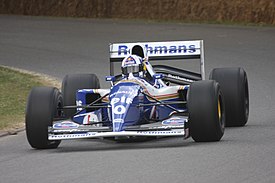Williams FW16

David Coulthard driving the FW16B at the 2009 Goodwood Festival of Speed
|
|||||||||||
| Category | Formula One | ||||||||||
|---|---|---|---|---|---|---|---|---|---|---|---|
| Constructor | Williams | ||||||||||
| Designer(s) |
Patrick Head (Technical Director) Adrian Newey (Chief Designer) |
||||||||||
| Predecessor | FW15C | ||||||||||
| Successor | FW17 | ||||||||||
| Technical specifications | |||||||||||
| Chassis | Carbon fibre and Aramid monocoque | ||||||||||
| Suspension (front) | Williams inboard torsion spring, double wishbone, operated by pushboard bellcrank | ||||||||||
| Suspension (rear) | Williams inboard coil-spring, double wishbone, operated by pushboard bellcrank | ||||||||||
| Axle track | Front: 1,670 mm (66 in) Rear: 1,590 mm (63 in) |
||||||||||
| Wheelbase | 2,920 mm (115 in) | ||||||||||
| Engine | Renault RS6 / RS6B / RS6C, 3,493 cc (213.2 cu in), 67° V10, NA, mid-engine, longitudinally mounted | ||||||||||
| Transmission | Williams transverse 6-speed semi-automatic | ||||||||||
| Fuel | Elf | ||||||||||
| Tyres | Goodyear | ||||||||||
| Competition history | |||||||||||
| Notable entrants | Rothmans Williams Renault | ||||||||||
| Notable drivers | 0. 2. 2. 2. |
||||||||||
| Debut | 1994 Brazilian Grand Prix | ||||||||||
|
|||||||||||
| Constructors' Championships | 1 (1994) | ||||||||||
| Drivers' Championships | 0 | ||||||||||
The Williams FW16 is a Formula One car designed by Adrian Newey for the British Williams team. The FW16 competed in the 1994 Formula One season and was used by British driver Damon Hill to finish runner-up in the 1994 World Drivers' Championship. It was also the car in which 3 time world champion Ayrton Senna was killed during the third race of the 1994 season, the San Marino Grand Prix. Its engine was a Renault RS6 3.5 V10. The team's main sponsor was Rothmans, replacing Camel Cigarettes and Canon used on the FW14 and FW15C. The car was designed around the major regulation changes that the FIA had introduced in the off-season, banning the various electronic devices that had been used by the front running cars during the preceding two seasons.
The FW16 was a passive evolution of the FW15C that had preceded it. It featured revised bodywork, including a low profile engine cover; taller sidepods; enclosed driveshaft; and an anhedral rear wing lower element, which was previously hinted at on the FW15C. In addition to these changes, the FW16 featured an innovative rear suspension wishbone design, an improved version of the Renault Sport Formula One engine (RS6), and a fuel valve to enable the ability for mid-race refuelling (a rule reintroduced for 1994).
As with the previous season, the number 0 car was driven by Damon Hill for the entire year, as reigning champion Alain Prost had taken his number 1 with him when he left the sport. The number 2 car was driven by Ayrton Senna, David Coulthard and Nigel Mansell. Although it was fast, the car proved to be a tricky proposition in early testing and in the early part of the season. The car had a number of problems that were not properly remedied: a design flaw was discovered in the car's frontal section and there were attempts to correct this in time for the ill-fated third race, at the San Marino Grand Prix. Various other alterations were made by Newey and Patrick Head to alleviate the car's handling problems, such as the addition of bargeboards at the Spanish Grand Prix; the FIA-mandated modifications to the airbox at the French Grand Prix; and shorter sidepods at the Hungarian Grand Prix. This heavily revised B-spec car was labelled the FW16B from the German Grand Prix onwards. It was developed by Hill, but the Benetton B194 and Michael Schumacher were dominant in the first half of the season. Rookie test driver David Coulthard shared the second car with former champion Nigel Mansell (who also had IndyCar commitments).
...
Wikipedia
